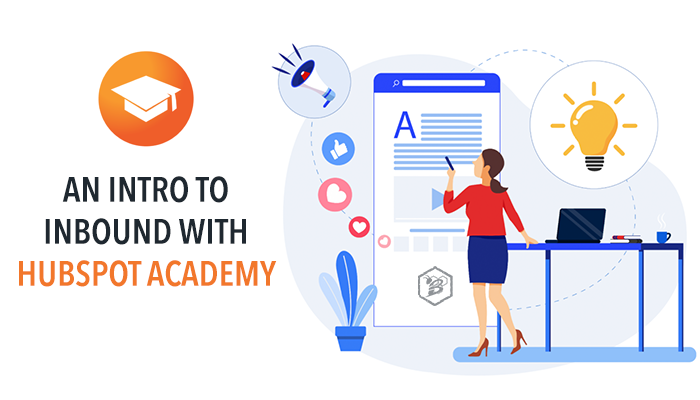As a new member of the HIVE, part of my onboarding process has been earning relevant certifications from HubSpot Academy. I’m a new copywriter on the team, and while I’ve been working in marketing for the last five years, I’m new to HubSpot. Let the certifications begin!
Throughout my writing experiences I’ve sharpened my skills creating content across a broad variety of topics for a number of industries and created content for websites, social media, and print. Despite using the principles of inbound marketing in the past, I couldn’t have given you a definition for what inbound is until I completed the inbound certification course on HubSpot Academy.
I’d Like to Thank the Academy
Before diving into the world of inbound methodology, I started my learning process by familiarizing myself with the tools. HubSpot Academy has dozens of free courses across marketing, sales, and customer service disciplines — from content marketing to SEO to inbound sales.
The lessons within each course are a mixture of videos, quizzes, and occasional challenges to put your new knowledge into practice. Each course is broken into subtopics, and each subtopic has a handful of video lessons. The videos vary in length, with some only a minute or two long and others up to fifteen minutes depending on the complexity or density of the topic. The course breakdown is easily visible and tracks your progress as you go, which made it easy to take a break and come back to the course as it fit my schedule.
I completed the Inbound certification course in a single workday, along with a few other onboarding tasks and a break for lunch. The course was easy to follow and easy to pause so I could take notes on topics I wasn’t familiar with. At the end of the course, I had a new way to think about marketing and the content I was creating.
What is Inbound?
According to HubSpot Academy, the inbound methodology is a method of attracting, engaging, and delighting people to grow a business in a way that provides value and builds trust. Inbound influences all aspects of a business, from marketing to sales to customer service.
From a content perspective, the emphasis is on creating value. To attract prospective customers the inbound method focuses on building relevant and helpful content, which then builds trust in customers as they engage. From there, continued content, whether it’s social media, blog posts, email newsletters, or web copy all works to delight customers every time they interact with that business.
.png?width=300&name=inbound-methodology%20(1).png)
In order to attract and engage customers, the inbound methodology for content creation focuses on thought leadership. This is content that a business produces as an expert in what they do. After all, that’s how a business gets off the ground—by offering their customers a solution or service to fix a problem or need. By offering prospective customers value from your knowledge base it establishes your business as a thought leader. Combine that trust instilled in readers with good SEO, content marketing practices, and a descriptive call-to-action and you have a (simplified) inbound content marketing strategy!
The Inbound certification course only takes about two hours to complete. After the introductory course, there are over a dozen other inbound courses to dive into. Up next on my to-do list is the Inbound Marketing certification, but you may be interested in Inbound Sales, or how to use inbound methodology to create a marketing strategy or plan.
If you’re new to HubSpot Academy, the Inbound certification is a great course to get started with. Many of the topics introduced in the course—including buyer personas, the buyer’s journey, and setting business goals—are expanded upon in other courses. And since HubSpot and all its tools are based on inbound methodology, it’s useful to understand why HubSpot works the way it does from a higher level.
How HubSpot's Inbound Methodology Has Changed My Writing
As a copywriter I know the power of good content, and I would like to think that all the copy I’ve written over the last five years has provided value or entertainment to my readers. But in the marketing world, that value is often a priority or two below tools like SEO optimization or the call-to-action.
In a digital world where content is king, it’s easy to whip up a blog post filled with keywords, dust off your hands, and call it a day. But anyone who has ever read a blog post that felt like reading white noise knows that content for the sake of content doesn’t attract, engage, or delight.
Whenever I’m writing a new piece of content, there are a few questions I keep in mind to guide the content and ensure that it holds to inbound methodology.
- Why is the audience reading this piece?
- What is my audience hoping to get from this piece?
- Is this piece of content providing value in the form of knowledge or entertainment?
These questions are all pretty similar, but if I can’t answer them all it likely means that I’m writing content without a clear purpose. As the writer, if I can’t figure out why I’m creating a piece, my audience will feel the same way. That’s a sure way to lose a reader’s interest and certainly won’t be building up trust in a potential customer.
Great content can drive traffic to a website, social media channels, and towards making a purchase. With the HubSpot Academy and inbound methodology, my content can reach new heights as I expand my marketing toolbox and continue to learn.
If you’re interested in adding a few more tools to your business tool belt, checkout HubSpot Academy and the Inbound certification course. Or, if you’re interested in inbound marketing for your business but have enough on your plate, let us take some work off your hands with comprehensive inbound marketing services.




.png?width=100&height=100&name=Why%20Were%20Not%20a%20Marketing%20Agency%20(And%20What%20That%20Means%20for%20Your%20Growth).png)
